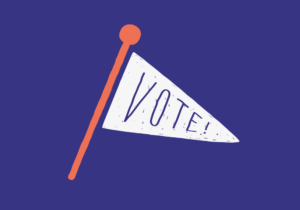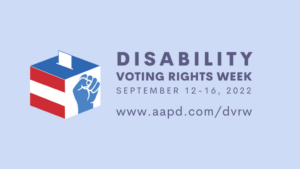This blog was originally posted by US Vote Foundation on their blog and reposted with permission as part of a series of blogs. The US Vote Foundation recently published their Resources for Voters with Disabilities initiative in honor of Disability Voting Rights Week.
 38 Million. That’s the number of eligible voters with disabilities in the U.S. This week, September 12-16, is Disability Voting Rights Week. Learn why the disability vote matters and how you work to build the power of the disability vote with us.
Disabled voters make up one of the largest voting blocs in the country. Many politicians and lawmakers prefer to think of us as passive members of society, content to be left out of the political process. But this could not be farther from the truth.
Disabled people are activists and organizers, candidates and voters, caregivers and recipients of care, community leaders and volunteers, patients and doctors, employees and CEOs. We have many reasons to care about elections and how they impact our lives. The people and policies we vote on impact our access to transportation, employment, healthcare, community, privacy, and so much more.
Even though voters with disabilities have many reasons to vote in elections, there is still a 6% turnout gap between voters with and without disabilities. This means that fewer people with disabilities are voting than non-disabled people. Our community has less of a say in the very policies that impact our lives. This doesn’t mean that disabled voters are less politically engaged than voters without disabilities. Access barriers create this turnout gap.
Some barriers that keep disabled voters from participating in elections include inaccessibility at every part of the voting process, discrimination from others, exclusion from the political process by candidates and campaigns, and social isolation from digital and physical access barriers to the community.
38 Million. That’s the number of eligible voters with disabilities in the U.S. This week, September 12-16, is Disability Voting Rights Week. Learn why the disability vote matters and how you work to build the power of the disability vote with us.
Disabled voters make up one of the largest voting blocs in the country. Many politicians and lawmakers prefer to think of us as passive members of society, content to be left out of the political process. But this could not be farther from the truth.
Disabled people are activists and organizers, candidates and voters, caregivers and recipients of care, community leaders and volunteers, patients and doctors, employees and CEOs. We have many reasons to care about elections and how they impact our lives. The people and policies we vote on impact our access to transportation, employment, healthcare, community, privacy, and so much more.
Even though voters with disabilities have many reasons to vote in elections, there is still a 6% turnout gap between voters with and without disabilities. This means that fewer people with disabilities are voting than non-disabled people. Our community has less of a say in the very policies that impact our lives. This doesn’t mean that disabled voters are less politically engaged than voters without disabilities. Access barriers create this turnout gap.
Some barriers that keep disabled voters from participating in elections include inaccessibility at every part of the voting process, discrimination from others, exclusion from the political process by candidates and campaigns, and social isolation from digital and physical access barriers to the community.
 In 2016, the American Association of People with Disabilities (AAPD) launched the REV UP Voting Campaign and Disability Voting Rights Week to address this gap in voting outreach and advocacy. REV UP builds the power of the disability vote through grassroots coalition building, voting outreach to disabled voters, and advocating for more accessible voting.
Closing the 6% voter turnout gap between people with and without disabilities would mean close to 2 million more votes from people with disabilities. Learn how you can join REV UP in making sure disabled voters are registered and ready to vote and have access to the ballot in 2022 and beyond!
Find REV UP at aapd.com/revup and on social media at @RevUPCampaign.
In 2016, the American Association of People with Disabilities (AAPD) launched the REV UP Voting Campaign and Disability Voting Rights Week to address this gap in voting outreach and advocacy. REV UP builds the power of the disability vote through grassroots coalition building, voting outreach to disabled voters, and advocating for more accessible voting.
Closing the 6% voter turnout gap between people with and without disabilities would mean close to 2 million more votes from people with disabilities. Learn how you can join REV UP in making sure disabled voters are registered and ready to vote and have access to the ballot in 2022 and beyond!
Find REV UP at aapd.com/revup and on social media at @RevUPCampaign.
 38 Million. That’s the number of eligible voters with disabilities in the U.S. This week, September 12-16, is Disability Voting Rights Week. Learn why the disability vote matters and how you work to build the power of the disability vote with us.
Disabled voters make up one of the largest voting blocs in the country. Many politicians and lawmakers prefer to think of us as passive members of society, content to be left out of the political process. But this could not be farther from the truth.
Disabled people are activists and organizers, candidates and voters, caregivers and recipients of care, community leaders and volunteers, patients and doctors, employees and CEOs. We have many reasons to care about elections and how they impact our lives. The people and policies we vote on impact our access to transportation, employment, healthcare, community, privacy, and so much more.
Even though voters with disabilities have many reasons to vote in elections, there is still a 6% turnout gap between voters with and without disabilities. This means that fewer people with disabilities are voting than non-disabled people. Our community has less of a say in the very policies that impact our lives. This doesn’t mean that disabled voters are less politically engaged than voters without disabilities. Access barriers create this turnout gap.
Some barriers that keep disabled voters from participating in elections include inaccessibility at every part of the voting process, discrimination from others, exclusion from the political process by candidates and campaigns, and social isolation from digital and physical access barriers to the community.
38 Million. That’s the number of eligible voters with disabilities in the U.S. This week, September 12-16, is Disability Voting Rights Week. Learn why the disability vote matters and how you work to build the power of the disability vote with us.
Disabled voters make up one of the largest voting blocs in the country. Many politicians and lawmakers prefer to think of us as passive members of society, content to be left out of the political process. But this could not be farther from the truth.
Disabled people are activists and organizers, candidates and voters, caregivers and recipients of care, community leaders and volunteers, patients and doctors, employees and CEOs. We have many reasons to care about elections and how they impact our lives. The people and policies we vote on impact our access to transportation, employment, healthcare, community, privacy, and so much more.
Even though voters with disabilities have many reasons to vote in elections, there is still a 6% turnout gap between voters with and without disabilities. This means that fewer people with disabilities are voting than non-disabled people. Our community has less of a say in the very policies that impact our lives. This doesn’t mean that disabled voters are less politically engaged than voters without disabilities. Access barriers create this turnout gap.
Some barriers that keep disabled voters from participating in elections include inaccessibility at every part of the voting process, discrimination from others, exclusion from the political process by candidates and campaigns, and social isolation from digital and physical access barriers to the community.
 In 2016, the American Association of People with Disabilities (AAPD) launched the REV UP Voting Campaign and Disability Voting Rights Week to address this gap in voting outreach and advocacy. REV UP builds the power of the disability vote through grassroots coalition building, voting outreach to disabled voters, and advocating for more accessible voting.
Closing the 6% voter turnout gap between people with and without disabilities would mean close to 2 million more votes from people with disabilities. Learn how you can join REV UP in making sure disabled voters are registered and ready to vote and have access to the ballot in 2022 and beyond!
Find REV UP at aapd.com/revup and on social media at @RevUPCampaign.
In 2016, the American Association of People with Disabilities (AAPD) launched the REV UP Voting Campaign and Disability Voting Rights Week to address this gap in voting outreach and advocacy. REV UP builds the power of the disability vote through grassroots coalition building, voting outreach to disabled voters, and advocating for more accessible voting.
Closing the 6% voter turnout gap between people with and without disabilities would mean close to 2 million more votes from people with disabilities. Learn how you can join REV UP in making sure disabled voters are registered and ready to vote and have access to the ballot in 2022 and beyond!
Find REV UP at aapd.com/revup and on social media at @RevUPCampaign.